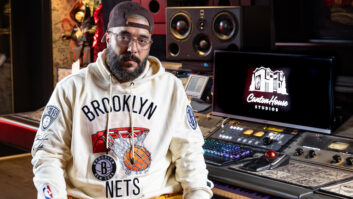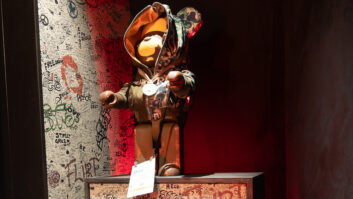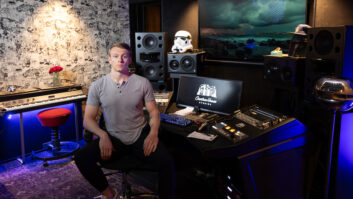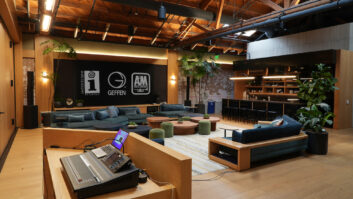Zambri recently released its debut album, House of Baasa, but the collaborations stretch far back for the duo. As sisters, Cristi Jo and Jessica Zambri have created music together for years, gaining a firm command of their ethereal mix of electronica, ambient, goth and pop in the process. Now, with the release of the album and their recent Glossolalia EP, the pair have garnered raves from the New York Times, NME, Spin, Under The Radar, Fader and others. Self-produced by the pair of New Yorkers in their respective Chinatown and Greenwich Village apartments, the music itself is imbued with an off-kilter yet epic majesty, developed in part from such disparate sources as toys, dusty cassette demos and old-fashioned vocal manipulation. With that in mind, we talked with Cristi Jo and album mixer Rick Kwan to discover how House of Baasa was built.

You employed some unusual production techniques; how did some of that come about—happy accidents, deliberate experimentation, making the most of the resources available or something else?
Cristi Jo: I think a lot of this album entailed “making the most” with what we had. You think about how you want something to sound, and you make it as best you can with what you have. It pushes you into a very creative head space, and I think it was important for this album to sit where it sits. It will make us remember that creativity should more resources become available to us. We’re really comfortable making sounds in a scrappy way. I think mainly it comes from the urgency to lay something down however you just made it. There’s no time to get fancy. You just have to put it down and leave it. Sometimes you can recreate it, but when you do, you always know about the magical one that was there first.
You recorded going back and forth between your apartments—do you each have similar recording equipment, or did you carry gear from one place to the other?
We have similar set ups. We traded some equipment such as microphones, compressors etc. Generally speaking, whatever we brought to one another traveled in a backpack.
Did you take up production out of necessity or is it something you see as an extension of your musical creative process?

Most definitely we started playing and writing in a way that didn’t involve computers. The production side of things is really inspiring to both of us, and I would definitely say it’s an extension of the creative process. You can sit there for hours upon hours creating a whole new world that playing doesn’t allow. You can make a symphony or teach a choir without actually finding and paying an orchestra or vocalists. A lot of people may say it’s less organic, but I think it can sometimes represent your most natural self. Whatever is in your head all the time, you can put to record. It’s very inspired, in the moment and urgent. I love love love amazing musicians and improvisation. It’s a whole different kind of inspiration, and I think that the two shouldn’t be combative. It’s different forms of art and music. I appreciate and like to be a part of both. They are fulfilling in different ways. I think I’d get bored if they didn’t coexist.
What was it like to bring in someone else [mixing engineer Rick Kwan] into the process after recording the record yourselves for so long?
We met Rick through another musician friend. Jess and I were really nervous about mixing with anyone else. I’m specifically terrible at working with others in a musical capactiy, so it was an exercise that taught me to loosen my tie. His demeanor is incredible. He dealt with two crazyheads. He has great ideas, and I can’t say enough great things about him. We have him and Chris Coady to thank for opening us up to working with minds new to our circle.
What was some of the gear used for mixing? Any challenges in getting the mixes together as you envisioned them?
Rick Kwan: Mixing was done entirely in the box; the tracks were exported from Logic and mixed in Pro Tools. Since the tracks came from so many different sources—drums recorded at a practice space, virtual instruments in Logic, found sounds from the internet, iPhone recordings, pro studio vocal overdubs, etc.—it was sometimes a challenge to create mixes where everything existed in a similar world. We spent some time cleaning up tracks that were recorded at home or from various unconventional sources, with filters and noise-reduction software like Waves’ X-Noise. Other invaluable plug-ins included the Sound Toys Decapitator, Echo Boy and Crystalizer.
So with the album out now, looking back, what was the coolest moment during its creation?
Cristi Jo: Gosh, I don’t know if I can answer that. The mixing process was interesting because we were experiencing it again, being reminded of parts we’d forgotten about. It was more relaxed, and listening to each part soloed was really trippy. We’d take breaks because we got a little scared or emotional. I remember thinking I wanted to release an album of all the individual parts. I thought it could be used for a movie trilogy or something. It was really mind-blowing listening to it like that for me. What a terrible idea though. That was goofy.
What’s next for Zambri?
The Oscars. The Grammys. The Moon. Probably a coffee. You?







